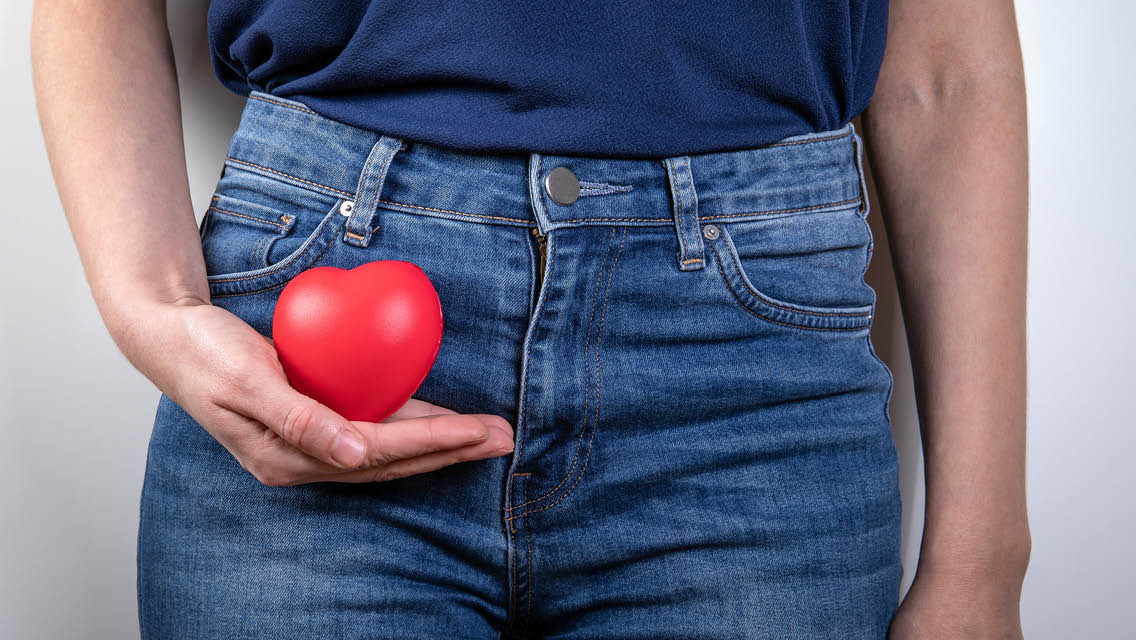“Endometriosis is an immune and inflammatory problem that’s triggered by cyclic hormonal changes and worsened by chronic environmental-toxin exposure,” explains integrative-medicine physician and herbalist Aviva Romm, MD. While the exact causes of the condition remain unclear, these are some possible contributing factors.
1) Retrograde Menstruation
Among the possible causes of endometriosis, explains Cindy Geyer, MD, a functional-medicine physician at the UltraWellness Center in Lenox, Mass, a primary suspect is retrograde menstruation. “The cells of the endometrium, instead of flowing outward as in a menstrual period, flow backward up the fallopian tube and end up in the abdominal cavity. Once they’re there, they can take up residence and attach to the ovaries or other organs.”
Still, this condition alone can’t explain endometriosis. “Most women have some degree of retrograde menstruation,” Geyer says. “It’s actually normal.”
In most cases, the innate immune system recognizes the cells as a foreign presence in the abdomen, and it destroys them, she notes. “So, what is it that defines the 10 or 11 percent of women for whom those cells end up in the abdominal cavity and don’t get taken care of by the innate immune system?”
To answer that, Geyer says we need to look at “secondary imbalances that create an environment in which the cells attach, grow, proliferate, and cause a perpetuating cycle of inflammation and scarring.”
2) Hormonal Imbalance
Our sex hormones, adrenal hormones, and thyroid hormones interact in dynamic and complex ways. When considering hormonal conditions, it can be more useful to look at the balance — or imbalance — among hormones rather than at any single one in isolation. “In people with endometriosis, we tend to see less progesterone on board and more estrogen,” says integrative practitioner Marcelle Pick, OB-GYN, NP.
Endometriosis is considered an estrogen-related disease because that hormone acts as a sort of fertilizer for the growth of the errant cells. Many of the conventional treatments for the condition, such as birth control pills, aim to decrease the production of estrogen and increase progesterone, which helps thin both the lining of the uterus and endometrial lesions.
Yet endometrial implants can generate estrogen themselves, creating more fertilizer for their own growth. This is why birth control pills, hysterectomy, and even menopause don’t always reliably relieve the condition.
Estrogen metabolism and detoxification are key to reducing overall estrogen load. Genetics play a role here, as do environmental toxins, which increase the burden on the body’s detoxification system.
3) Genetics
There’s evidence of a genetic component to endometriosis, though no single gene has been identified as the culprit. “Endometriosis is more common in first-degree relatives of women who’ve had endometriosis,” Geyer says. “There also seems to be an epigenetic component, in which the intrauterine environment can influence the baby’s future risk for endometriosis.” (Epigenetics describes the way our behaviors and environments affect our gene expression.)
Specifically, fetal exposure to endocrine-disrupting chemicals, such as dioxins, PCBs, phthalates, and bisphenol A (BPA), is suspected of contributing to increased risk.
“If we have genetic SNPs, we’re more prone to have poor methylation, or to have our bodies express estrogen in a more potent way,” Pick explains. (An SNP, or single nucleotide polymorphism, is a genomic variant at a single base position in the DNA.)
Particular genes can affect our ability to break down estrogen and other environmental toxins or increase progesterone resistance. (For more on how genetic variations can influence our health, see “What Are SNPs and Why Do They Matter?”)
Genes, however, are not destiny. Through diet and lifestyle, we’re able to reduce our toxic load and support our detoxification processes.
4) Environmental Toxins
Evidence suggests that increased exposure to environmental toxins called endocrine disruptors, which disrupt or mimic our natural hormones, could be contributing to the widespread development of endometriosis. Food packaging, personal-care products, and plastic water bottles frequently contain these hormone-disrupting chemicals, which “may stimulate endometriosis growth as a result of increased chronic inflammation, increased estrogen synthesis, and altered monthly thickening and shedding of the uterine wall,” explain Andrew Cook, MD, and Danielle Cook, MS, RD, CDE, in their book, The Endometriosis Health and Diet Program.
Evidence suggests that increased exposure to environmental toxins called endocrine disruptors, which disrupt or mimic our natural hormones, could be contributing to the widespread development of endometriosis.
BPA and phthalates fall into this category, and some studies have found that women with endometriosis had higher phthalate concentrations in their blood. “BPA has a similar structure to estrogen and can behave like estrogen; however, the body takes much longer to metabolize it,” the Cooks write. BPA can also disrupt estrogen signaling, exacerbating endometriosis symptoms.
5) Dysbiosis
An imbalanced microbiome and leaky gut can contribute to chronic inflammation, a risk factor for endometriosis. “We also now have studies indicating correlation between endometriosis and an imbalanced microbiome,” explains Pick. In addition to the microbiome of the intestines, she adds, “we also have a microbiome of the uterus that can be imbalanced.”
These microbial imbalances can disrupt normal immune function and may contribute to the development of endometriosis. Studies in mice have even shown successful endometriosis treatment using antibiotics that kill the overgrowth of hostile bacteria. Specifically, low levels of Lactobacillus bacteria have been linked to the disease, as have high levels of microbes related to bacterial vaginosis (Explore eight ways to balance your vagina’s pH level at “How to Support Your Vaginal Microbiome.”)
Certain bacteria even affect how the body metabolizes estrogen. “The microbiomes of the gut and uterus actually affect the entire physiology of the body, from hormonal balance to digestion,” notes Pick.
6) Inflammation
“More and more, we’re starting to look at endometriosis as an inflammatory cascade,” says Pick. The cascade begins with irritation and tissue damage and ends in fibrosis and scarring. Each stage adds more inflammation to the cycle, making it both a cause and an effect of endometriosis. Inflammation also contributes to the amount of pain women with endometriosis experience.
Food is a key factor. “We know that diet affects inflammation systemically, particularly a diet high in sugar and refined carbohydrates,” Geyer notes. Stress, poor sleep, and overall toxic load can also contribute to systemic inflammation.
This perspective offers a key entry point for treating endometriosis and relieving symptoms, Pick says. “Anything you can do to decrease that inflammatory cascade will help decrease pain and cramping.”
7) Stress
Stress can worsen endometriosis symptoms in several ways. “I don’t think that stress causes endometriosis, but it can certainly disrupt the health of the gut lining and increase inflammation,” Geyer explains.
Over time, chronic stress and pain can contribute to central sensitization, in which the central nervous system alters perception of pain. In these cases, “even a sensation such as light touch or cold temperature that ordinarily wouldn’t register as pain gets perceived as pain,” says Geyer. “Everything’s on hyperalert.”
Chronic stress can also lead to hormone dysregulation, in part by overworking the thyroid and adrenal glands. This sets the stage for the kind of hormonal imbalances that foster the growth of endometrial implants.
8) Dysregulated Immunity
Impaired immune surveillance and response may play a role too, mainly by allowing endometrial cells to grow outside the uterus. “One theory is that natural killer cells aren’t responding as they should and getting rid of endometrial cells,” Geyer explains. “And if there’s already inflammation inside the abdominal cavity, that creates an environment where those tissues are more likely to latch on and take up residence.”
The peritoneal fluid of patients with endometriosis has been shown to contain unusually high levels of the molecule galectin-3. “This molecule is produced by the immune system and is implicated in every single condition that involves fibrosis, such as nonalcoholic fatty liver disease and pulmonary fibrosis,” she notes.
Researchers speculate that galectin-3 not only hinders natural killer cells from detecting endometrial cells, but it allows the endometrial cells to become stickier, contributing to ongoing scarring. Drugs that target galectin-3 are currently in development.
Explore how dietary and lifestyle adjustments can alleviate the discomfort of this painful condition by reading “A Functional-Medicine Approach to Endometriosis,” from which this article was excerpted.





This Post Has 0 Comments